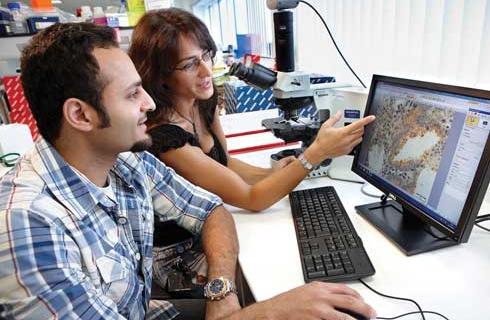Master of Science in Oceanography- Physical Oceanography

学历文凭
Masters Degree

专业院系
化学和物理海洋学

开学时间

课程时长

课程学费

国际学生入学条件
A GPA of 3.0 or better in the last four semesters or approximately 60 semester credits (or the equivalent in quarter credits) of work as an undergraduate;
To be eligible, an applicant must hold or expect to hold prior to matriculation a bachelor’s degree from a regionally accredited U.S. college or university, or an equivalent degree from a recognized non-U.S. institution of higher education.
All international applicants are required to submit one transcript or academic record from each institution of higher education attended, including any study abroad or exchange programs, summer programs, and non-degree work and extension programs. Applicants may submit unofficial copies of transcripts while applying for admission. However, admitted students are required to submit official transcripts in order to enroll at UHM. Official transcripts or academic records must be sent to Graduate Division Student Services directly from the issuing institution(s), or in sealed institutional envelopes if submitted with the application.
Applicants are required to submit one transcript from each post-secondary institution attended, including any study abroad or exchange programs, summer programs, and non-degree work and extension programs. Applicants may submit unofficial copies of transcripts while applying for admission. However, admitted students are required to submit official transcripts in order to enroll at UHM.
TOEFL iBT - Minimum score 61 TOEFL iBT
IELTS- Minimum score is 6.00 for the IELTS Academic overall band test results.
IDP—雅思考试联合主办方

雅思考试总分
6.0
了解更多
- 雅思总分:6
- 托福网考总分:61
- 托福笔试总分:160
- 其他语言考试:NA
CRICOS代码:
申请截止日期:请 与IDP联系 以获取详细信息。
课程简介
The Physical Oceanography Division conducts research and educational activities to understand the dynamics (movement, mixing, and exchange with atmosphere and land) of the ocean. These processes interact and vary across the small-scale (turbulent mixing), the human-scale (waves, coastal zone), the storm scale (sub-to-mesoscale, transfer between ocean and atmosphere), to the planetary scale (El Nio, climate). Current research topics within the division include, but not limited to: physical and biological interactions in the oceans, sub-mesoscale and mesoscale structures, water-type formation, dynamics of the ocean's surface layer, satellite remote sensing, ocean-atmosphere interaction, paleoceanography, ecosystem modeling, sea-level rise, equatorial circulation, general ocean circulation variability and dynamics, climate dynamics, ocean circulation and wave predictability, and technological development of instruments and sensors.<br>Ocean physics can impact people's lives from changes to rain and weather patterns, sea-level rise, coastal waves and dynamics, changes in ocean mixing of carbon, and much more. In addition to basic research, these applied areas are currently examined by members of the Division.
相关申请

预科

奖学金

实习机会

在校学习

跨境学习

校园授课-线上开始

在线/远程学习
学校排名
世界排名
201
数据源:泰晤士高等教育世界大学排名
本校相关课程
Master of Science in Zoology

学历文凭
Masters Degree
下一个开始日期
课程费用总额
Master of Urban and Regional Planning

学历文凭
Masters Degree
下一个开始日期
课程费用总额
Master of Science in Tropical Plant Pathology

学历文凭
Masters Degree
下一个开始日期
课程费用总额
Master of Science in Tropical Plant and Soil Sciences

学历文凭
Masters Degree
下一个开始日期
课程费用总额
Master of Science in Travel Industry Management

学历文凭
Masters Degree
下一个开始日期
课程费用总额
Master of Fine Arts in Theatre

学历文凭
Masters Degree
下一个开始日期
课程费用总额
其他相关课程
Doctor of Philosophy in Oceanography

康涅狄格大学
泰晤士高等教育世界大学排名:382

学历文凭
Ph.D.
下一个开始日期
课程费用总额
物理治疗硕士

韦仕敦大学
泰晤士高等教育世界大学排名:

学历文凭
Masters Degree
下一个开始日期
课程费用总额
Graduate Certificate in Oceanography

科罗拉多大学博尔德分校
泰晤士高等教育世界大学排名:

学历文凭
Graduate Certificate
下一个开始日期
课程费用总额
海洋学理学学士

不列颠哥伦比亚大学
泰晤士高等教育世界大学排名:

学历文凭
Bachelor Degree
下一个开始日期
课程费用总额
Master of Oceanography

罗德岛大学
泰晤士高等教育世界大学排名:976

学历文凭
Masters Degree
下一个开始日期
课程费用总额
海洋与大气科学理学学士-海洋学

迈阿密大学
泰晤士高等教育世界大学排名:239

学历文凭
Bachelor Degree
下一个开始日期
课程费用总额




